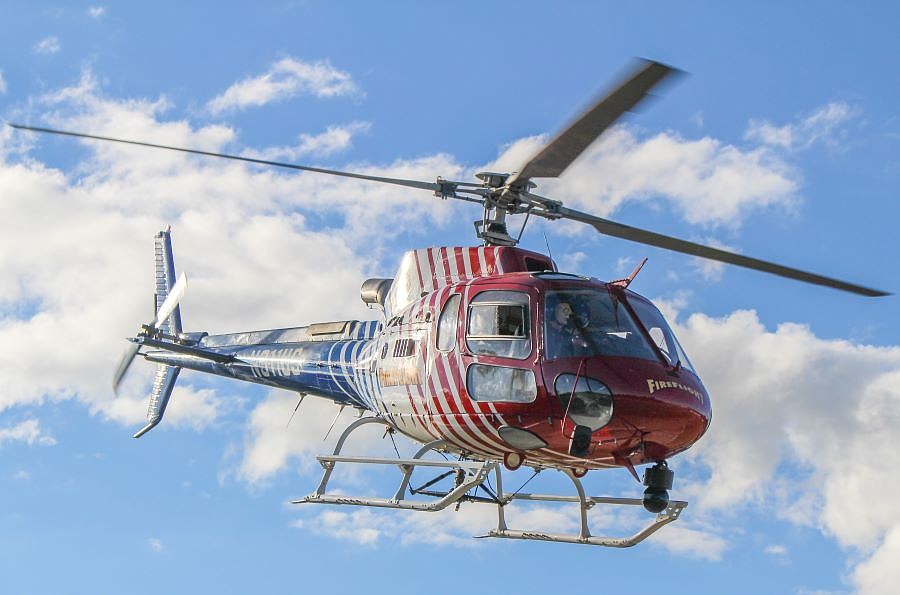- April 25, 2024
-
-
Loading

Loading

FireFlight Pilot Todd Whaley has twice in as many months visited schools with the county’s helicopter to make a twofold impression: the nimble aircraft can do a number of things, including dousing brushfires before they become newsworthy wildfires, and that being a helicopter pilot and mechanic is an awesome job.
His latest student outreach venture was to a private K-12 in Ormond Beach called Riverbend Academy.
“There is a shortage of helicopter pilots and mechanics. I think it’s because young people aren’t exposed to what they can do,” Whaley said. “This is the time to make an impression on them – plant that seed. I still remember my first plane ride when I was 5 years old like it was yesterday. I wasn’t on my first helicopter until my 20s when I was in the military (Navy), and the experience changed my whole career outlook.”
Flight Operations Chief Dana Morris – who only missed out on this opportunity and the presentation in February at University High School in Orange City because of the way he and Whaley’s shifts rotate – concurs that engaging the public is a highlight.
“I love doing outreach – especially with children and students,” Morris said. “We are proud of Flagler County’s fire protection program with FireFlight, and we love to share what we do. (Before COVID), at the airshows at Flagler Executive Airport, I must lift 200 kids in and out of the helicopter. It’s a thrill for them.”
As part of his presentation at Riverbend Academy, Whaley demonstrated for the students how to use FireFlight’s 210-gallon “Bambi bucket” to scoop water out of the pond in front of the school and moments later release its impressive payload. The added benefit of demonstrations for the pilots is that it provides an extra opportunity to practice, which keeps their skills sharp.
“It’s important to understand that we may put out six or eight little fires that no one (public) really knows about, but it's preventing those big fires that threaten property and structures,” Whaley said. “Depending on the conditions (such as drought index), we may do reconnaissance once or twice a day so we can get 'em while they're small.”
Whaley refers to the county’s helicopter program as “the mouse that roars.”
“Our program is the most in-depth progressive program east of the Rockies,” he said. “Others may call out their helicopters for the big fires, but they aren’t out consistently training and containing or extinguishing the small ones.”
Whaley and Morris work hand-in-hand not only with Fire Rescue but also with the Florida Forest Service on fire suppression missions. Though conditions haven’t been ripe for an operation since the first of the year, the team is trained and prepared to assist the Land Management Department with aerial ignition of a prescribed fire as part of its mitigation program.
“This process is safer and faster than lighting the fire from the ground,” said Prescribed Fire Program Supervisor Mike Orlando. “A more complete ignition prevents big walls of fire that roast the trees instead of just clearing the underbrush, and it keeps firefighters from having to walk through that dangerous brush.”
The FireFlight team also trains in conjunction the Fire Rescue marine rescue team on ocean rescue techniques where rescue swimmers are deployed from the helicopter to combine efforts with rescuers on jet skis.
FireFlight also assists law enforcement, is used for search and rescue, and serves as Flagler County’s air ambulance. The helicopter can travel anywhere within the county in 15 minutes.
It was purchased after the '98 wildfires – the first time in U.S. history that an entire county was evacuated due to wildfire. During those fires 71 homes were destroyed, and another 175 homes were damaged.
About 82,000 acres of timber – valued at $4,000 per acre – burned. The timber loss alone was $328 million. Flagler County spent about $1.3 million in protective measures in 1998.
FireFlight was purchased in 2002 for $1.55 million with Landfill Bond money designated for fire suppression. No General Fund money was used.
Countless wildfires have been quashed with the help of FireFlight, which is a great asset to Flagler County. More than 1.7 million gallons of water have been dropped on fires since 2002.